In this installment of the Hidden Voices series, we’re sharing the story of activist Judy Heumann, a daughter of Holocaust survivors whose advocacy would earn her the nickname “the Mother of the Disability Rights Movement” for her important role in the fight for equal access for people with disabilities.
Hidden Voices began as a collaboration with the Museum of the City of New York that was initiated to help City students learn about the countless individuals who are often “hidden” from traditional historical records. Each of the people highlighted in this series has made a positive impact on their communities while serving as outstanding examples of leadership, advocacy, and community service.
Today, in celebration of Jewish American Heritage Month, we’re sharing the story of activist Judy Heumann, a daughter of Holocaust survivors whose advocacy would earn her the nickname “the Mother of the Disability Rights Movement” for her important role in the fight for equal access for people with disabilities.
When Section 504 of the Rehabilitation Act of 1973 was first passed, disability rights advocates were hopeful for what the law could mean: if enforced, it would dramatically increase protections for individuals with disabilities in the United States. But years passed, and the transformation that had been promised had not come to pass. Now, those advocates were pushing the Secretary of Health, Education, and Welfare (HEW) to sign the set of regulations that was necessary for Section 504 to be enacted for a long time. By April of 1977, they were tired of waiting.
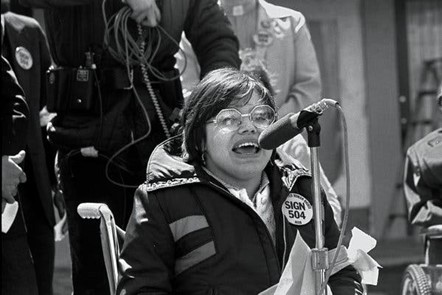 Judy Heumann speaking in favor of enacting Section 504 regulations prior to the 1977 sit in protests.
Judy Heumann speaking in favor of enacting Section 504 regulations prior to the 1977 sit in protests.
Source: HolLynn D'Lil; Accessed via the New York Times.
The activists set a deadline for the HEW Secretary to take action. When he still refused, protestors entered HEW offices across the country on April 5 and declared that they would not leave the building until the regulations were signed. In most cities, the sit-in did not last long; barred from accessing food and medication critical for their health and safety, the activists were forced to leave. But in the San Francisco offices, things were different—there, a woman named Judy Heumann was leading the charge.
Heumann, who was born in 1947, contracted polio when she was only 18 months old—at the height of the disease’s outbreak in the United States. An iron lung kept her breathing for nearly 3 months, and her battle against the virus left her paralyzed and unable to walk for the rest of her life.
Her parents, Werner and Ilse Heumann, were German Jewish immigrants who were both among the roughly 1,400 children and teenagers sent to the United States from Germany to the United States as Hitler came to power in the 1930s. While they were fortunate to escape, Judy’s grandparents, great-grandparents, and many other family members who stayed behind were killed in the Holocaust. In addition to the loss of their own relatives, an estimated 200,000 people with disabilities were murdered between 1940 and 1945—a connection that Heumann believed drove their decision not to surrender her to an institution, which was common practice during the worst of the polio outbreak.
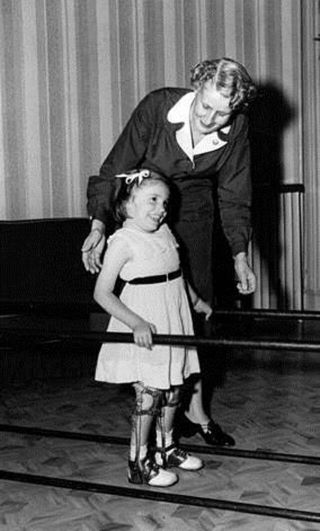 Judy and her mother, Ilse Heumann, when Judy was a young child. Ilse was a fierce advocate for her daughter throughout her life, and fought for Judy's right to an equal education in her childhood.
Judy and her mother, Ilse Heumann, when Judy was a young child. Ilse was a fierce advocate for her daughter throughout her life, and fought for Judy's right to an equal education in her childhood.
Source: Forbes. In fact, Judy learned later in life that her doctors had recommended that her parents send her away to one of these facilities, but they had refused. Instead, their experiences as immigrants and survivors instilled in the entire Heumann family the importance of speaking out against injustices and a strong belief in equality and justice for all people. These values led Judy’s parents to become fierce advocates on her behalf throughout her childhood in Brooklyn. In fact, Heumann attributes many of the opportunities she had as a child to her mother’s persistence. It was because of her mother’s efforts, for example, that Judy was eventually permitted to attend public school—a fight that took half a decade for their family to finally win.
At first, Judy was prohibited from attending kindergarten because, the principal told them, she was considered “a fire hazard” in her wheelchair. There were no protections at the time for children with disabilities when it came to their right to an education, and Judy was repeatedly denied access to public and private schools alike.
As a result, Judy had to be homeschooled until she was nine years old, when she was finally offered a spot in a program called Health Conservation 21—a program for children with disabilities offered in various public schools across New York City. The program was located in the basement of another public school, and those who attended were completely separated from students without disabilities. The “kids upstairs,” as Heumann nicknamed them, also received nearly double the number of hours of instruction time as Judy and her other fourth grade classmates, whose ages ranged from nine to twenty-one.
Despite the inequities that Judy faced, she also recalled that her time in Health Conservation 21 fostered bonding experiences that began to teach her about disability culture. She reflected on this in her memoir, writing that “‘disability culture’ is really just a term for a culture that has learned to value the humanity in all people, without dismissing anyone for looking, thinking, believing, or acting differently… Because we were kids doing what kids naturally do until they are taught otherwise: Slow down enough to listen and truly see each other. Ask questions. Connect. Find a way to have fun. Learn.”
Judy knew that neither she nor her classmates in Health Conservation 21 were expected to succeed academically, but she was determined to prove those who doubted her wrong. She went on to be the first student from the program to attend high school, becoming a student at Sheepshead Bay High School after her mother successfully pushed the Board of Education to make several schools in each borough wheelchair accessible with support staff. This experience was her first time in an integrated learning environment, with both students with and without disabilities in her classes. Though the adjustment was difficult for her at times, she succeeded once again; after she graduated, Judy was accepted to and went on to attend Long Island University (LIU) for college.
Judy found a community of other students with disabilities at LIU who shared a belief that their “lack of access [was] a problem with society, rather than [an] individual problem.” Inspired by the Civil Rights movement of the 50s and 60s, as well as the ongoing protests against the Vietnam War at the time, Heumann began to engage with activism and organizing for the first time on her college campus, winning a seat on the student council where she fought for accommodations such as ramps to be built on campus. The students she befriended dreamed of passing a law that would be like the Civil Rights Act of 1964 for people with disabilities, who were not protected by that original legislation.
 Heumann in 1970—the year that she was denied her teaching license from the New York City Board of Education.
Heumann in 1970—the year that she was denied her teaching license from the New York City Board of Education.
Source: Evelyn Straus, NY Daily News; Accessed via CNN.
Although she was engaged in activism during college, however, Judy didn’t envision her advocacy as her career. Instead, she wanted to be a teacher. She had not been able to major in education, due to stipulations around a scholarship that required proof of other people with similar disabilities working in whatever field she chose to study; however, there were no teachers who also used wheelchairs who Judy could point to, as there were no legal protections for people with disabilities that would have prevented hiring discrimination.
Still, Judy was determined, and graduated from LIU with a degree in speech therapy through an alternate route offered by the New York City Board of Education at the time. Unfortunately, Judy was—literally—unable to get her foot in the door. “Just five steps led up to the brass-plated double front doors of the New York City Board of Education at 110 Livingston Street, but I didn’t bother to count the steps just then,” she recalled. “It could have been twenty-five or ten or two and it wouldn’t have mattered.”
Nevertheless, Judy passed all of the necessary tests that she needed to become a teacher—except for one: because she was a wheelchair user, she did not pass a mandatory health exam intended to check for communicable diseases that might be passed onto children in a classroom. Judy had no such illnesses, but was once again forced to battle assumptions that her presence in a classroom would be unsafe for the children around her, particularly in emergency situations. She tried to argue that, in case of an evacuation, the motorized wheelchair she now used was faster than a person walking anyway, but her arguments were disregarded by those in charge. She was denied a teaching license, for no reason other than her disability.
Having anticipated this, Heumann decided to pursue legal action. At 22 years old, she sued the New York City Board of Education for her right to teach and—after Judge Constance Baker Motley urged the board to reconsider their decision— she became the first teacher to use a wheelchair in New York City's history.
Her experience with the BOE was her first foray into the disability rights movement outside of college—and she would not stop there. Several years later, Heumann moved to Berkeley, California, where the movement was blossoming, and helped found the Center for Independent Living, one of many advocacy organizations she would be a part of throughout her lifetime.
It was while she was living in California that the fight for Section 504 began ramping up.
When the 1977 protests first began, Heumann gave a speech outside the HEW building that summarized what they were there fighting for: “For too long,” she said, “we have believed that if we played by the rules and did what we were told, we would be included in the American Dream. We have waiting too long, made too many compromises, and been too patient. We will no longer be patient. There will be no more compromise. We will accept no more discrimination.”
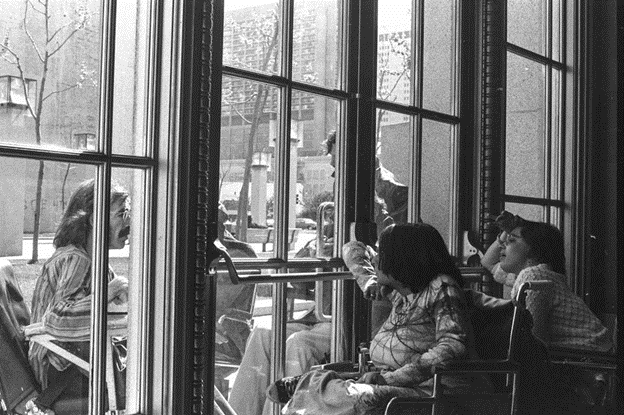 Protestors across the country in 1977 occupied federal buildings across the country to advocate for Section 504 regulations. Pictured here are Mike Williams (left) outside the San Fransisco HEW office communicating with Nancy D'Angelo (center) and Judy Heumann (center), who were among those inside the building. The San Francisco protest was one of the longest running and most successful of the sit-ins.
Protestors across the country in 1977 occupied federal buildings across the country to advocate for Section 504 regulations. Pictured here are Mike Williams (left) outside the San Fransisco HEW office communicating with Nancy D'Angelo (center) and Judy Heumann (center), who were among those inside the building. The San Francisco protest was one of the longest running and most successful of the sit-ins.
Source: HolLynn D'Lil; Accessed via Forbes.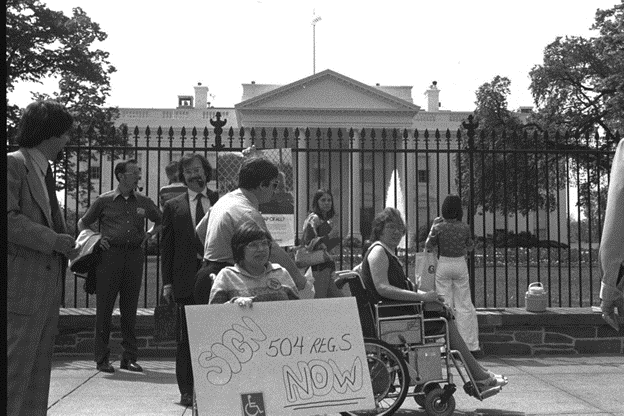 Judy Heumann holds a sign that reads "SIGN 504 REGS NOW" in front of the White House in April 1977, alongside another disability rights activist, Kitty Cone.
Judy Heumann holds a sign that reads "SIGN 504 REGS NOW" in front of the White House in April 1977, alongside another disability rights activist, Kitty Cone.
Source: HolLynn D'Lil; Accessed via the New York Times.
The protestors were serious about their demands: for 26 days, over 100 protestors in San Francisco occupied the HEW building in support of Section 504, refusing to accept a compromise when it came to their civil rights. To this day, it remains the longest non-violent occupation of a federal building in U.S. history ever.
During that time, protestors had to get creative in order to survive in the building and sustain their momentum. Other organizations who supported their cause—including the Black Panther Party—provided meals. They maintained contact with the press, and kept attention on their story, by using sign language to communicate with Deaf protestors on the outside. In the end, they succeeded, and the regulations that they were advocating for were signed without changes.
Section 504 was transformative. It stated, for the first time, that “No otherwise qualified individual with a disability in the United States…shall, solely by reason of his or her disability, be excluded from the participation in, be denied the benefits of, or be subjected to discrimination under any program or activity receiving Federal financial assistance.” With that one sentence, the lives of thousands of people with disabilities would change forever, as they finally were entitled to equal access to schools, jobs, and their communities under the law.
Not only did the law make huge strides towards creating a more accessible and equitable society, but it also changed the very way people thought about disability. “People had been internalizing the idea that our barriers were our individual problem for so long,” Heumann wrote in her memoir, “it was hard to shift. People had to get out of the habit of thinking ‘I can’t get up the steps because I can’t walk’ and get used to thinking ‘I can’t get up the steps because they’re not accessible.” She also wrote that “Section 504 had redefined disability. Instead of looking at disability as a medication issue, [Section 504] had made disability a question of civil—and human—rights.”
Even still, Heumann knew there was still work to be done; she continued her advocacy work in the years to come, cofounding the World Institute on Disability in 1980, through which she fought for the passage of the Americans with Disabilities Act, also known as the ADA.
When the ADA finally passed in 1990, it became the first law that officially defined the rights of people with disabilities. It helped make public spaces and public transit more physically accessible, and prevented employment discrimination when it came to both hiring and pay. In the three decades since the ADA passed, day-to-day life for individuals has transformed; curb cuts, ramps, elevators have become more commonplace, closed captions and audio description for movies and television are more readily available, and more.
 Disability rights advocates in 1993 in New York City at the "Disability Independence Parade." Heumann and her fellow advocates often used the Civil Rights Movement as a model for their own activism. Judy Heumann is pictured third from the left alongside Paul S. Miller, Phyllis Rubenfeld and Justin Dart. Dart played a major role in the passage of the ADA, and was there when President George H.W. Bush signed it into law.
Disability rights advocates in 1993 in New York City at the "Disability Independence Parade." Heumann and her fellow advocates often used the Civil Rights Movement as a model for their own activism. Judy Heumann is pictured third from the left alongside Paul S. Miller, Phyllis Rubenfeld and Justin Dart. Dart played a major role in the passage of the ADA, and was there when President George H.W. Bush signed it into law.
Source: NYC Mayor’s Office for People with Disabilities.
Beyond that, the law also opened pathways for legal recourse for those that faced discrimination because of their disability, and paved the way for future laws that have continued to make the country and more accessible and equitable place.
After the ADA was signed, Heumann took on a role in the Department of Education under the Clinton administration—becoming the highest-ranking person with a disability in the U.S. government. Later, she also worked for the World Bank, was the first director of Washington D.C.’s Disability Services Department, and then became a special adviser for international disability rights at the U.S. State Department, under President Barack Obama. In 2020, she appeared in the Oscar nominated documentary, Crip Camp about the lives of teenagers with disabilities who attended Camp Jened in the Catskills in the 1970s—a childhood experience that had a profound impact on Heumann's life.
“Some people say that what I did changed the world. But really, I simply refused to accept what I was told about who I could be. And I was willing to make a fuss about it."
– Judy Heumann
Heumann passed away in 2023 at 75 years old. Even throughout her last years, Judy continued to fight for a world with Universal Design—one that would be accessible to everyone, no matter what their specific needs were. As the fight for accessibility and disability rights continues today, the impact of Judy’s work on thousands of individuals will reverberate for generations to come. Her tireless advocacy helped change the lives of thousands of people with disabilities.
“Some people say that what I did changed the world,” Heumann wrote in her memoir. “But really, I simply refused to accept what I was told about who I could be. And I was willing to make a fuss about it.”
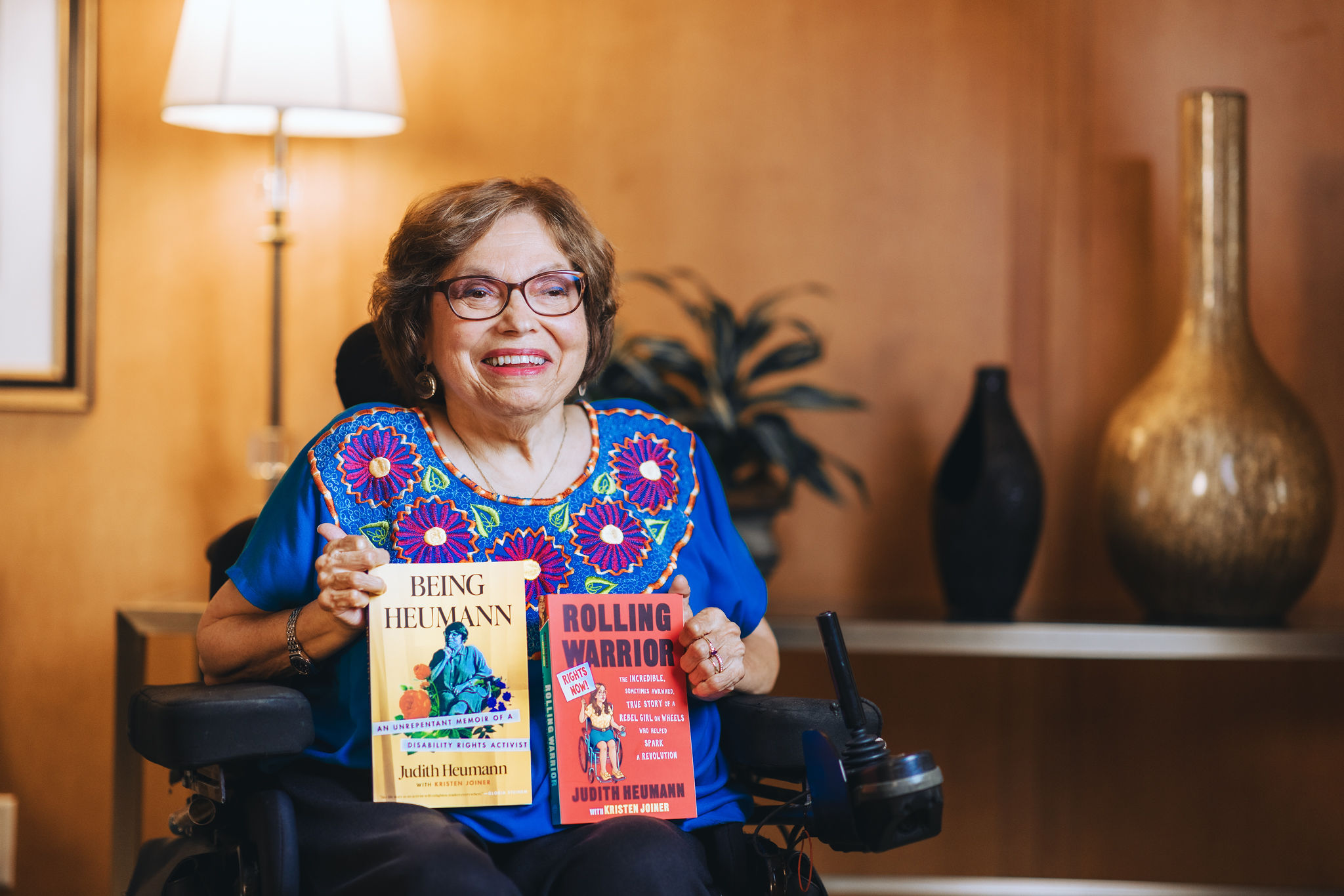 Judy wrote two memoirs during her lifetime: Being Heumann: An Unrepentant Memoir of a Disability Rights Activist, which was published in 2020, and the young adult version, Rolling Warrior, which was published shortly thereafter.
Judy wrote two memoirs during her lifetime: Being Heumann: An Unrepentant Memoir of a Disability Rights Activist, which was published in 2020, and the young adult version, Rolling Warrior, which was published shortly thereafter.
Source: Mike Dawkins; Accessed via JudithHeumann.com
Sources
Beaubien, J. (2012, October 15). Wiping Out Polio: How the U.S. Snuffed Out a Killer. NPR. https://www.npr.org/sections/health-shots/2012/10/16/162670836/wiping-out-polio-how-the-u-s-snuffed-out-a-killer
Carmel, J. (2020, July 22). Before the A.D.A., There Was Section 504. The New York Times. https://www.nytimes.com/2020/07/22/us/504-sit-in-disability-rights.html
Carson, D. P. (2020, October). Judy Heumann. Ability Magazine. https://abilitymagazine.com/judy-heumann/
Cat-Wells, K. (2023, March 7). The Extraordinary Life and Legacy of Judith Heumann: A Trailblazer For Disability Rights. Forbes. https://www.forbes.com/sites/keelycatwells/2023/03/07/the-extraordinary-life-and-legacy-of-judith-heumann-a-trailblazer-for-disability-rights/
Center for Independent Living, Inc. (2023, March). Honoring Judith Heumann. CIL. https://www.centerforindependentliving.org/honoring-judith-heumann
Cokley, R. (2023, March 6). Opinion: Judy Heumann’s Life Is a Testament and A Reminder. CNN. https://www.cnn.com/2023/03/06/opinions/judy-heumann-disability-rights-activist-cokley-ctrp/index.html
Cone, K. (2013, April 4). Short History of the 504 Sit-In. Disability Rights Education and Defense Fund. https://dredf.org/504-sit-in-20th-anniversary/short-history-of-the-504-sit-in/
Grim, A. (2015, July 8). Sitting-In for Disability Rights: The Section 504 Protests of the 1970s. National Museum of American History. https://americanhistory.si.edu/blog/sitting-disability-rights-section-504-protests-1970s
Heumann, J. (2016, October). Our Fight for Disability Rights—And Why We’re Not Done Yet. TED. https://www.ted.com/talks/judith_heumann_our_fight_for_disability_rights_and_why_we_re_not_done_yet/transcript?language=en
Heumann, J., & Joiner, K. (2020). Being Heumann: An Unrepentant Memoir of a Disability Rights Activist. Beacon Press.
Heumann, J., & Joiner, K. (2020, April 9). The Power of Spaces Built for People with Disabilities. Literary Hub. https://lithub.com/the-power-of-spaces-built-for-people-with-disabilities/
Kuta, S. (2023, March 6). What Made Judy Heumann, Mother of the Disability Rights Movement, an American Hero. Smithsonian Magazine. https://www.smithsonianmag.com/smart-news/disability-rights-activist-judy-heumann-dies-at-age-75-180981752/
Lathrop, D. (2011, January 1). New Mobility’s 2010 Person of the Year: Judith Heumann. New Mobility. https://newmobility.com/new-mobilitys-person-of-the-year-judith-heumann/
Leiderman, D. (2020, March 25). The Activist Star of ‘Crip Camp’ Looks Back at a Life on the Barricades. The New York Times. https://www.nytimes.com/2020/03/25/movies/crip-camp-judy-heumann.html
Lombard, S. (2015, July 13). 8 ways in which the Americans with Disabilities Act changed everyone’s lives. National Museum of American History. https://americanhistory.si.edu/blog/8-ways-which-americans-disabilities-act-changed-everyones-lives
Museum of Jewish Heritage. (2021, July 28). Legacies: Judy Heumann. Museum of Jewish Heritage—A Living Memorial to the Holocaust. https://mjhnyc.org/blog/legacies-judy-heumann/
Ott, K. (2015, July 1). Celebrating 25 years of the Americans with Disabilities Act. National Museum of American History. https://americanhistory.si.edu/blog/celebrating-25-years-americans-disabilities-act
Peterson, J. (2015, July 15). Smashing barriers to access: Disability activism and curb cuts. National Museum of American History. https://americanhistory.si.edu/blog/smashing-barriers-access-disability-activism-and-curb-cuts
Polio Victim Wins Teacher’s License. (1970, June 20). The New York Times, 17.
Rothberg, E. (2023). Biography: Judith Heumann. National Women’s History Museum. https://www.womenshistory.org/education-resources/biographies/judith-heumann
Section 504, Rehabilitation Act of 1973. Retrieved from http://www.dol.gov/agencies/oasam/centers-offices/civil-rights-center/statutes/section-504-rehabilitation-act-of-1973
Shoot, B. (2017, November 9). The 1977 Disability Rights Protest That Broke Records and Changed Laws. Atlas Obscura. http://www.atlasobscura.com/articles/504-sit-in-san-francisco-1977-disability-rights-advocacy
Sonneborn, L. (2021, June 28). Disability Rights Timeline. College of Education and Human Development, Institute on Disabilities, Temple University. https://disabilities.temple.edu/resources/disability-rights-timeline
Stevenson, R. W. (2002, June 24). Justin Dart Jr., 71, Advocate For Rights of Disabled People. The New York Times, 8.
Taub, A. (2023, March 5). Judy Heumann, Who Led the Fight for Disability Rights, Dies at 75. The New York Times. https://www.nytimes.com/2023/03/05/obituaries/judy-heumann-dead.html
The Heumann Perspective. (2020). Judy Heumann (1947-2023). Judy Heumann. https://judithheumann.com/project/about/
The United States Holocaust Memorial Museum. The Murder of People with Disabilities. Holocaust Encyclopedia. Retrieved from https://encyclopedia.ushmm.org/content/en/article/the-murder-of-people-with-disabilities
Viadero, D. (1993, April 28). Activist on Disability Rights, Nominee Has Battled Schools Before. Education Week. https://www.edweek.org/education/activist-on-diability-rights-nominee-has-battled-schools-before/1993/04
Wallis, L. (2020, December 6). The disabled activist who led a historic 24-day sit-in. BBC. https://www.bbc.com/news/stories-54794408
Wolfe, K. (2023). Judith Heumann. In The Shalvi/Hyman Encylopedia of Jewish Women. The Jewish Women’s Archive. http://jwa.org/encyclopedia/article/heumann-judith
Zinn Education Project. April 28, 1977: Disability Rights Sit-Ins Force Enactment of Section 504. Zinn Education Project. Retrieved from https://www.zinnedproject.org/news/tdih/sit-ins-force-504/
Banner collage photos accessed via New Mobility Magazine (left); Smithsonian National Museum of American History ("Sign 504" Button); New York City Mayor's Office for People with Disabilities (center); Judy Heumann, "About Judy" (right)